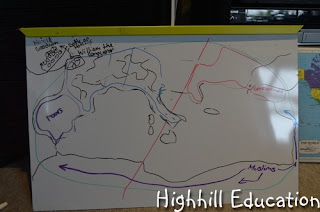Week 2 - We learned about what happened after the western half of the Roman Empire fell and built a model of the Hagia Sophia's dome.
After the western Roman Empire fell, Europe was in turmoil, but the eastern empire thrived for another 1000 years. Here is a very simple and brief overview of the time period between 500 AD and 1000 AD known as the Dark Ages in western Europe and the Byzantine Empire in eastern Europe and western Asia.
Because the Roman Empire grew to a great size and became difficult to defend, the empire was split in two. Rome was the capital of the west and Constantinople was the capital of the east.
The western Roman Empire ran out of money and couldn't pay the army, so the army invaded Rome. Soon after, the capital and lands were invaded by many other tribes such as the Goths, Visigoths and Vandals.
The turmoil lead to a complete breakdown in leadership and infrastructure. To survive, the people of the west formed small kingdoms. (Each circle represents a kingdom.) The kingdoms fought with each other.
In the east, Christianity was flourishing by force. The city of Constantinople was strengthened with walls and an extensive water system which included grand underground cisterns. The people had public baths, running water, public entertainment and lived in relative comfort.
While the Byzantine Empire continued to thrive, an Emperor named Charlemagne began to unite the lands of Northern Europe. He forced Christianity, repaired roads, and built schools. Although the country wasn't ready, the period when Charlemagne ruled was a mini-Renaissance.
Meanwhile, the Muslims were growing across Northern Africa. Eventually they crossed into Spain across the Straits of Gibraltar and restored the economy by introducing water management technology and new crops. They brought their religion and came to be known as the Moors.
When Charlemagne died, the empire he built crumbled. Not long after the Vikings attacked at many locations.
In Brittan they were confronted and expelled by Alfred the Great, but in Northern France they managed to win land known today as Normandy.
William the Conqueror, a descendent of the Normandy Vikings, fought with Harold Goodwin in the Battle of Hastings in 1066 for the English crown.
While the people of Northern Europe were gathering together for the Crusades, the Moors in Spain were busy translating ancient texts from Arabic into Latin and sowing the seeds for the Renaissance.
To learn more about the Byzantine Empire, we watched the video Engineering an Empire - Byzantine.
The Byzantine Empire lasted 1000 years before it was eventually conquered by the Ottoman Turks. One of the first powerful emperors of the Byzantine Empire was Justinian. He was disliked by the people for his greed and brutality, but tried to make peace by building an incredible Christian Church.
The Hagia Sophia, located in Istanbul, was built in the year 537. With ground breaking technology, the Byzantines were able to create a huge interior space by building a dome, buttressed by semi-domes. After the Ottoman Turks conquered the city, the Hagia Sophia was converted into a mosque and was the main influence for constructing other mosques in the region. For that reason, the book Mosque by David Macaulay is an excellent book for obtaining a better idea of how the church was built.
by David Macaulay is an excellent book for obtaining a better idea of how the church was built.
Our Hagia Sophia dome was constructed from Legos.
and a dome.
After several collapses, the main supports were reconstructed from different blocks. Incidentally, the original dome of the Hagia Sophia also collapsed and had to be rebuilt.
The dome is supported on four arches.
The area in the corners between the arches is known as the pendentives. This technique of resting a dome on four arches and pendentives was developed by the Romans, but the Hagia Sophia is the first large scale building which uses the technique.
The dome was carefully put into place.
Sign-up to follow Highhill Education by email below.

This post is linked to:
Sola Gratia









_wm.JPG)







wonderfull
ReplyDeleteVery cool construction! You have a real talent for summing up the important events over a large chronological period, Julie.
ReplyDeleteLEGOS! They are such an awesome toy and learning tool. My oldest boy is just getting into them (which makes his engineer Daddy super happy) and I can see that incorporating them into our curriculum will be very beneficial.
ReplyDeleteAmazing teaching strategy! I know I loved my history lessons, but I'm pretty sure that the way you taught the break-up of the Roman Empire and the subsequent rise of the Byzantines can attract the undivided attention of even the most nonchalant kids. And of course the lego activity is a definite plus! Kudos to you for your creativity!
ReplyDeleteJan @ GradePowerLearning.com
So I think when you move to NC we need to do school together! LOL You rock! Thanks for linking-up! Colleen
ReplyDelete